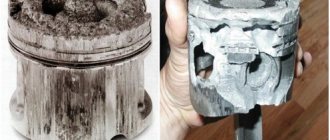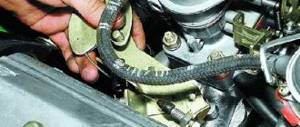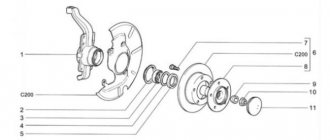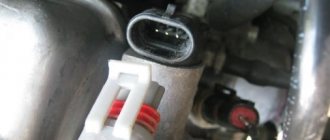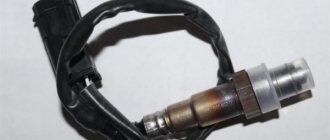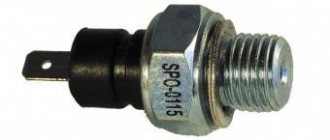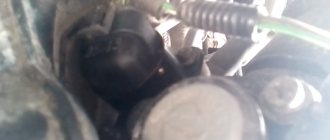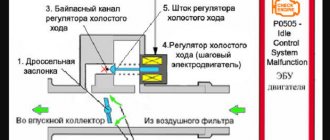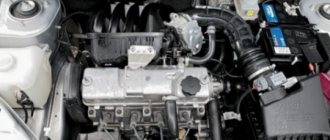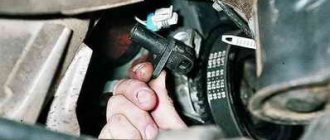Despite the fact that the car has a considerable number of installed sensors responsible for various parameters of its operation, only a few of them are of the greatest importance. These include the knock sensor of the VAZ 2114.
This device is used to record vibration (detonation) conditions of fuel during its direct combustion inside the engine. In addition, there is a constant transmission of data in the form of signals to the vehicle's ECU. As a result, the electronic unit adjusts (changes) the ignition timing. The importance of the device is due to the fact that if it fails or malfunctions, the ECU does not receive reliable data from it, and as a result, the detonation process is not damped.
The above circumstances have a destructive effect on the car engine. Therefore, negligence or failure to replace a part in a timely manner can destroy any motor. And this is not an exaggeration.
From this article you will learn why a knock sensor is needed, what problems may occur during its operation, and how to check and replace the sensor yourself.
Where is the knock sensor of the VAZ 2114
It is located between the second and third cylinders on the engine block (if viewed from the radiator side). Its location from the point of view of providing simple, unobstructed access is conveniently implemented in eight valve engines. But in more complex engines (16 valves), some inconvenience appears. This is due to the high density and accumulation of units in the engine compartment.
Operating principle of the knock sensor
Essentially, this is a non-separable round housing that has a hole for fixing on the cylinder block, as well as terminals used for connection to the vehicle’s on-board network. The main part of the sensor is a piezoelectric element located inside and generating small electrical impulses when subjected to mechanical action. When detonation occurs, sound waves with a frequency of 25-75 Hz are formed. They spread throughout the cylinder block and reach the piezocrystal, causing it to vibrate in unison with the “arriving” sound. Moreover, the greater the amplitude, the stronger the generated voltage. The generated pulses enter the on-board computer.
Most common faults
In fact, cases of failure of the detonation detection device itself are not so common. In most cases, the reasons for incorrect operation are auxiliary factors, such as:
- Damage to the wires connecting the control unit to the sensor. As a result, the unit does not read signals from the device; contamination of the metal part of the part;
- corrosion (as a result of environmental influences);
- chafing breaks and wires;
- oxidation of one or both contacts.
Less commonly, there is a complete failure of the internal piezo element (plate) of the device. In most cases, the sensor cannot be repaired, and the repair itself is not entirely rational in terms of effort, time and money. The surest way is to buy a new product; fortunately, it is not expensive.
Signs of malfunction of the knock sensor VAZ 2114
The knock sensor of the VAZ 2114 is a device on the serviceability of which the overall performance of the engine of the fourteenth depends. If the sensor fails, you will notice the following changes in the operation of the car:
- twitching of the internal combustion engine of the car;
- reduction in power indicators;
- an error appears on the instrument panel;
- increasing engine operating temperatures and rapid heating;
- increased fuel consumption;
- persistent smell of gasoline.
In order to understand the reason for the incorrect operation of the internal combustion engine, it is necessary to connect a diagnostic tool. Such a device allows you to read and display the code of a particular error. In our case, the following codes are distinguished: from 0325 to 0327 inclusive. All of them indicate that the sensor is not working properly.
Causes of detonation
We have figured out the features of this effect, so now we need to figure out why this very detonation can occur.
| Cause | Explanation |
| Low quality of fuel used | When using fuel with a low octane number, its detonation is more difficult, which disrupts the operation of the ignition circuit of the air-fuel mixture |
| Incorrect ignition timing setting | To identify a malfunction, you should check the maximum and static value of the ignition timing. If they are discovered, serious problems may follow. DD must be verified |
| The combustion temperature of the mixture increases due to the lean composition | Due to a lean mixture, detonation occurs due to a decrease in fuel evaporation. As a result, the absorbed heat is reduced. This causes a sharp increase in temperature and the appearance of detonation. Visually, the malfunction can be determined by checking the spark plugs for deposits on them. |
| Malfunctions, increased back pressure inside the system | Any of these failures does not allow hot gases to exit the chamber, which causes detonation vibrations. |
| Operating the engine in extreme conditions | At critical loads, all the mentioned malfunctions combined may occur. These conditions include extreme heat |
When detonation occurs continuously, the engine and its components overheat. If this effect is not prevented, the power unit will soon fail completely. It is not a fact that even a major overhaul will allow it to be restored.
Article on the topic: Ball joint on the VAZ 2109: choosing a new one and replacing it
Examination
How much does a knock sensor cost for a VAZ 2114?
On VAZ 2114 cars of early production years there is a Lada sensor 21120385501001. It has an extremely low prevalence and because of this its price is high and amounts to 800-1300 rubles. The only commonly found analogue is General Motors 21120-3855010-01 with a cost of 1600-1800 rubles.
The original broadband DD has article number 21123855020. Its price is much lower and amounts to 100-160 rubles. Its good analogues are presented in the table.
Table - Good analogues of the original VAZ 2114 knock sensor
| Manufacturer | vendor code | Approximate cost, ruble |
| Fenox | SD10100O7 | 210-420 |
| Decaro | 2112-3855020 | 360-490 |
| Samara 2112 | 3855020 | 200-250 |
| Road map | 21123855020 | 260-380 |
| ERA | 550489 | 300-340 |
How to check the knock sensor of a VAZ 2114
Before replacing the knock sensor with a new product, there are several recommendations for checking its performance, as well as identifying the reasons for the incorrect operation of the device. If on 8 valve engines access to the product is quite free, then on sixteen valve engines you will have a little more difficulty. To check the functionality of the sensor itself, you can resort to two available methods:
- checking with a multimeter;
- Testing operation without removal.
How to check the knock sensor of a VAZ 2114 with a multimeter
To check the knock sensor of a VAZ 2114 with a multimeter, follow these steps:
- We dismantle the sensor (how to do this is written in the next section of the article);
- We connect the multimeter probes to the DD contacts (if it is two-contact), if it is single-contact, the first probe to the wire, the second to the device body;
- We switch the tester to voltmeter mode and set the upper measurement limit to 200 mV;
- Tap a screwdriver (or any metal object) on the sensor body;
- If the device is working properly, the multimeter will show voltage surges, the magnitude of which should be directly proportional to the force of the impact (this indicates that the device retains the ability to convert mechanical energy into alternating current). If the multimeter readings do not change, the DD does not work.
If you find out that the device itself is working properly, but DD errors are displayed on the on-board computer or the car is not working as it should, the problem is most likely in the oxidized contacts of the sensor. Treat them with WD-40 or a similar solvent, install the DD in place and check the result. If that doesn't help, replace the knock sensor.
How to check the VAZ 2114 knock sensor without removing it
The second method, without removing the knock sensor on the VAZ 2114, is as follows. First, you must start the car engine and maintain its speed in the range from one and a half thousand to two thousand.
At the same time, you need to find the sensor and freely reach it. After that, take a convenient metal tool or device, knock on the part several times with increasing force (the main thing is not to overdo it). If the device is in good working order, the engine speed should increase when tapping (remember the principle of both operation and adjustment by the ECU). If after tapping no reaction occurs, you should dismantle the sensor and check it thoroughly with the same multimeter.
In any case, it is recommended to carry out a visual inspection of the product itself and pay attention to the following features:
- tightness of sensor mounting and connection;
- the degree of corrosion and contamination on the device body;
- contact connection (over time it may oxidize and partially or completely lose conductivity).
Replacing the knock sensor on a VAZ 2114 - step-by-step instructions
Replacing the DD is an extremely simple process. You can change the knock sensor of a VAZ 2114 within 5 minutes; for this you only need a 20 or 13 socket wrench (depending on what specific type of sensor is installed on your fourteenth).
So, after receiving a large block of theoretical information, we will proceed to practical exercises and thoroughly analyze the entire process of replacing (removing) the sensor.
Instructions for 8 valve engine
To perform the work you will need a 13mm wrench or socket.
- We gain free access and unscrew the fastening nut.
- Then disconnect the contact wires from the device connector.
- We extract the part.
Reinstallation is carried out in the opposite sequence. Everything is quite simple.
Instructions for engine 16 valves VAZ 2114
We use the same tools as in the first case. The only addition is the need to remove the internal combustion engine protection and ensure a convenient position and access under the bottom of the car. To do this, you can place the car on an overpass or repair pit. The removal and installation process is similar to the first example.
Replacement
We have figured out the signs and causes of the malfunction. Therefore, it’s time to talk directly about how to properly replace the DD.
This need arises when receiving strange errors from the DD, tripping the engine.
Check the condition of the wiring first. It often turns out that the DD is working properly, but the cause of the problem is wiring and contacts that have broken or oxidized.
If you do not find any signs of malfunction in the wiring, then you will still have to replace the measuring device.
This is easy to do if you follow the instructions:
- You already know the location of the device, so open the hood and remove the DD using socket wrenches. You will need 13 or 20 millimeter wrenches. It depends on what type of sensor is installed specifically on your VAZ 2114.
- Arm yourself with a voltmeter, turn it on in operating mode within 200 MV and connect the device to the ends of the wiring of the faulty sensor.
- Gently tap the DD body with a screwdriver, while changing the frequency and strength of the blows applied. At the same time, monitor the readings of your voltmeter. If the measuring device does not produce any response, then the DD is definitely out of order. You just need to insert a new sensor in its place.
Useful tips
Recently, cases of selling defective spare parts and sensors without the necessary internal contents have become more frequent. Therefore, immediately after purchasing the product you need, it is recommended to check its performance with a multimeter. You should know that on older VAZ 2114 models the knock sensor (resonant) differs from modern products (broadband) in price, design features and operating principles. Therefore, you should buy a product that is designed specifically for your car model. A device with a resonant type of operation cannot be replaced by modern products without modifying the ECU.
What is this?
To understand the essence of this device, let’s name its key features.
- DD, that is, the knock sensor, plays one of the main roles in the functioning of the engine. The device is responsible for controlling the degree of detonation and can determine the causes and nature of such a phenomenon. By supplying the appropriate information from the DD to the electronic control unit, characteristics that can lead to unwanted detonation are corrected.
- AvtoVAZ engineers could specifically place the DD in such a way that if problems arise with it, the driver could quickly and efficiently fix the problem. Alas, for some reason this was not done. Therefore, you will find this sensor on the engine block between its 2nd and 3rd cylinders. You need to look from the radiator side. Despite the inconvenient location, due to its reliable design, the developers still managed to minimize the likelihood of its failure. But this does not protect against breakdowns 100 percent. Therefore, sometimes the DD still needs to be replaced.
- For the VAZ 2114 model, several types of DD are used - broadband, with 1 and 2 working contacts, as well as resonant ones.
- The functioning of the DD is based on the reaction of the piezoelectric effect. Therefore, the main component of the element is a piezoelectric plate. They begin to generate energy as soon as detonation voltage vibrations occur. It increases depending on the frequency of oscillatory movements. The voltage from the sensor is transmitted to the control unit, which automatically adjusts the ignition timing, while debugging the ignition reaction of the fuel and air mixture.
Article on the topic: How to connect fog lights on a VAZ 2110 with your own hands (why they may not light up)
DD location
Detonation phenomenon
First you need to understand the features of this phenomenon.
Externally, detonation manifests itself in the form of metallic sounds. With such noise, drivers usually say that their fingers are knocking.
But the occurrence of detonation is associated with an imbalance in the characteristics of the gasoline combustion process and a violation of the ignition timing. Because of this, the pressure and temperature inside the combustion chamber seriously increases, which leads to mini explosions of the air and fuel mixture. This manifests itself in the form of a sound similar to metal objects hitting each other.
